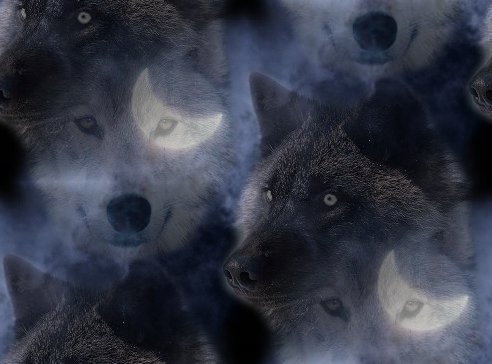
Diet


|
Choose suitably sized bones for your dog! This tiny sheltie pup ("Zoe") enjoys tucking into one of the 'big dogs' bones while they are not looking |
|
Anglo Wulfdogs, Wolfdogs and Wolf Lookalikes do best on BARF diet (Biologically Appropriate Raw Food). Generally speaking these dogs do not thrive on commercial 'complete' dog foods, although there are always exceptions who do, nor do they tolerate cereal based foods in large quantities. If you cannot bear the thought of feeding your dog its natural diet, then the only commercial complete dog foods that I can personally recommend are listed on my Links page, along with BARF suppliers. Feeding BARF can be as simple or as complicated as you want to make it and there are some very good articles and books on the subject. Variety is the spice of life and that goes for dogs too. If you consider the wild canines they do not go hunting with the preconceived notion that they must catch a balanced diet. They will make a kill and eat almost all the parts, offal, muscle, fat, hair and bone - the stomach contents will provide vegetables and herbs. Minerals they will find naturally and will often 'top up' with seasonal fruit and vegetation. They are also opportunists and will consume eggs if available. They might not get a balanced diet in one sitting, but over the course of time the wide variety consumed will ensure there are no deficiencies. With this in mind I believe that One Third Meat, One Third Vegetable and One Third Carbohydrate is about right. All meat and bones should be fed raw, while all vegetables and cereals should be gently cooked, as dogs are unable to break these down. The wider the variety you can feed, the better. Vitamins and minerals can be added in the form of SA37 or Stress (which is higher in calcium and not normally necessary if the dog is fed bones). Alongside raw mince (beef, chicken, lamb and rabbit) you can feed tripe (whole or minced) as well as fish. Chicken carcasses are a mainstay of BARF feeding, being cheap and easily consumed. Lamb ribs, lamb necks, turkey necks and chicken wings are all considered to be meaty bones. Large beef knuckle and marrow bones are recreational bones. Pasta and rice are also good to bulk out a meal and add variety but should be fed sparingly. Eggs are enjoyed cooked or raw, complete with shells. Heart, Liver etc. can also be fed sparingly but too much can be detrimental; I therefore prefer to keep these as training treats. Goats milk and bio yogurt are appreciated too. A 'pea sized' blob of garlic puree on their food daily will help to keep parasites at bay. Natural Bio yogurt will help to maintain a healthy gut flora and will quickly sort out minor digestive disorders. (If the dog appears lethargic, is vomiting or has a temperature seek veterinary advice). |

Recommended Reading: Give Your Dog a Bone: The Practical Commonsense Way to Feed Dogs for a Long Healthy Life by Ian Billinghurst Grow Your Pups with Bones: BARF Programme for Breeding Healthy Dogs and Eliminating Skeletal Disease by Ian Billinghurst The Barf Diet: For Cats and Dogs by Ian Billinghurst |

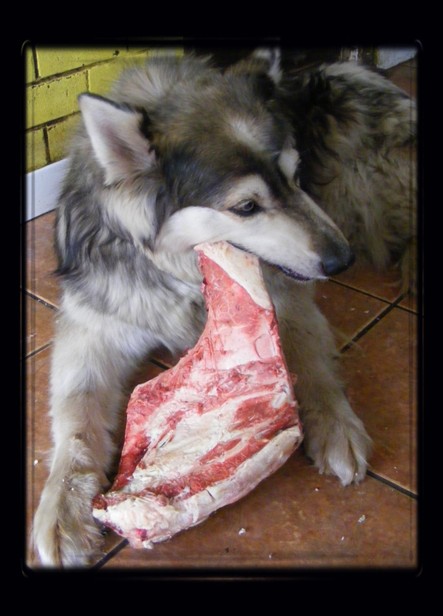 "Sky" has been enjoying BARF for over 10 years |
|
Tom Lonsdale Veterinary Surgeon PO Box 6096 Phone: +61 2 4578-1389 Windsor Delivery Centre Fax: +61 2 4578-1384 NSW 2756 E-mail: tom@rawmeatybones.com Australia Web: www.rawmeatybones.com January 2006 © Diet guide for domestic dogs and cats Dingoes and feral cats keep themselves healthy by eating whole carcasses of prey animals. Ideally we should feed our pets in the same manner. Until a dependable source of whole carcasses becomes available, pet owners need a satisfactory alternative. The following recommendations, based on raw meaty bones, have been adopted by thousands of pet owners with excellent results. The diet is easy to follow and cheap, and pets enjoy it. • Fresh water constantly available. • Raw meaty bones (or carcasses if available) should form the bulk of the diet. • Table scraps both cooked and raw (grate or liquidise vegetables, discard cooked bones). Puppies and kittens From about three weeks of age puppies and kittens start to take an interest in what their mother is eating. By six weeks of age they can eat chicken carcasses, rabbits and fish. During the brief interval between three and six weeks of age it is advisable to provide minced chicken, chicken carcasses or similar for young animals (as well as access to larger pieces that encourage ripping and tearing). This is akin to the part-digested food regurgitated by wild carnivore mothers. Large litters will need more supplementary feeding than small litters. (The meat and bone should be minced together. Meat off the bone can be fed, but only for a short time, until the young animals can eat meat and bone together — usually about six weeks of age.) Between four and six months of age puppies and kittens cut their permanent teeth and grow rapidly. At this time they need a plentiful supply of carcasses or raw meaty bones of suitable size. Puppies and kittens tend not to overeat natural food. Food can be continuously available. Natural foods suitable for pet carnivores Raw meaty bones • Chicken and turkey carcasses, after the meat has been removed for human consumption, are suitable for dogs and cats. • Poultry by-products include: heads, feet, necks and wings. • Whole fish and fish heads. • Goat, sheep, calf, deer and kangaroo carcasses can be sawn into large pieces of meat and bone. • Other by-products include: pigs’ trotters, pigs’ heads, sheep heads, brisket, tail bones, rib bones. Whole carcasses • Offal • Quality — Quantity — Frequency Healthy animals living and breeding in the wild depend on the correct quality of food in the right quantity at a correct frequency. They thereby gain an appropriate nutrient intake plus the correct amount of teeth cleaning — animals, unlike humans, ‘brush’ and ‘floss’ as they eat.Quality Low-fat game animals and fish and birds provide the best source of food for pet carnivores. If using meat from farm animals (cattle, sheep and pigs) avoid excessive fat, or bones that are too large to be eaten. Dogs are more likely to break their teeth when eating large knuckle bones and bones sawn lengthwise than if eating meat and bone together. Raw food for cats should always be fresh. Dogs can consume ‘ripe’ food and will sometimes bury bones for later consumption. Quantity Establishing the quantity to feed pets is more an art than a science. Parents, when feeding a human family, manage this task without the aid of food consumption charts. You can achieve the same good results for your pet by paying attention to activity levels, appetite and body condition. High activity and big appetite indicate a need for increased food, and vice versa. Body condition depends on a number of factors. The overall body shape — is it athletic or rotund — and the lustre of the hair coat provide clues. Use your finger tips to assess the elasticity of the skin. Does it have an elastic feel and move readily over the muscles? Do the muscles feel well toned? And how much coverage of the ribs do you detect? This is the best place to check whether your pet is too thin or too fat. By comparing your own rib cage with that of your pet you can obtain a good idea of body condition — both your own and that of your pet. An approximate food consumption guide, based on raw meaty bones, for the average pet cat or dog is 15 to 20 percent of body weight in one week or 2 to 3 percent per day. On that basis a 25 kilo dog requires up to five kilos of carcasses or raw meaty bones weekly. Cats weighing five kilos require about one kilo of chicken necks, fish, rabbit or similar each week. Table scraps should be fed as an extra component of the diet. Please note that these figures are only a guide and relate to adult pets in a domestic environment. Pregnant or lactating females and growing puppies and kittens may need much more food than adult animals of similar body weight. Wherever possible, feed the meat and bone ration in one large piece requiring much ripping, tearing and gnawing. This makes for contented pets with clean teeth. Frequency Wild carnivores feed at irregular intervals. In a domestic setting regularity works best and accordingly I suggest that you feed adult dogs and cats once daily. If you live in a hot climate I recommend that you feed pets in the evening to avoid attracting flies. I suggest that on one or two days each week your dog may be fasted — just like animals in the wild. On occasions you may run out of natural food. Don’t be tempted to buy artificial food, fast your dog and stock up with natural food the next day. Puppies, cats, ferrets, sick or underweight dogs should not be fasted (unless on veterinary advice). Table scraps Wild carnivores eat small amounts of omnivore food, part-digested in liquid form, when they eat the intestines of their prey. Our table scraps, and some fruit and vegetable peelings, are omnivore food which has not been ingested. Providing scraps do not form too great a proportion of the diet they appear to do no harm and may do some good. I advise an upper limit of one-third scraps for dogs and rather less for cats. Liquidising scraps, both cooked and raw, in the kitchen mixer may help to increase their digestibility. Things to avoid •Excessive meat off the bone — not balanced. •Excessive vegetables — not balanced. •Small pieces of bone — can be swallowed whole and get stuck. •Cooked bones — get stuck. •Mineral and vitamin additives — create imbalance. •Processed food — leads to dental and other diseases. •Excessive starchy food — associated with bloat. •Onions, garlic and chocolate — toxic to pets. . Grapes, raisins, sultanas, currants - toxic to pets. . Fruit stones (pits) and corn cobs - get stuck. •Milk — associated with diarrhoea. Animals drink it whether thirsty or not and consequently get fat. Milk sludge sticks to teeth and gums. Take care • • Pets with misshapen jaws and dental disease may experience difficulties with a natural diet. • Create variety. Any nutrients fed to excess can be harmful. • Liver is an excellent foodstuff but should not be fed more than once weekly. • Other offal, e.g. ox stomachs, should not exceed 50 percent of the diet. • Whole fish are an excellent source of food for carnivores, but avoid feeding one species of fish constantly. Some species, e.g. carp, contain an enzyme which destroys thiamine (vitamin B1). • There are no prizes for the fattest dog on the block, nor for the fastest. Feed pets for a lifetime of health. Prevention is better than cure. Miscellaneous tips Domestic dogs and cats are carnivores. Feeding them the appropriate carnivore diet represents the single most important contribution to their welfare. Establish early contact with a dependable supplier of foodstuffs for pet carnivores. Buy food in bulk in order to avoid shortages. Package the daily rations separately for ease of feeding. Refrigerated storage space, preferably a freezer, is essential. Raw meaty bones can be fed frozen just like ice cream. Some pets eat the frozen article; others wait for it to thaw. Small carcasses, for example rats, mice and small birds, can be fed frozen and complete with entrails. Larger carcasses should have the entrails removed before freezing. Take care that pets do not fight over their food. Protect children by ensuring that they do not disturb feeding pets. Feeding bowls are unnecessary — the food will be dragged across the floor — so feed pets outside by preference, or on an easily cleaned floor. Ferrets are small carnivores which can be fed in the same way as cats. For an expanded description of dietary requirements, including the potential hazards, please consult the books Raw Meaty Bones: Promote Health and Work Wonders: Feed your dog raw meaty bones.Further information, links and RMB Newsletters:http://www.rawmeatybones.com IMPORTANT: Note that individual animals and circumstances may vary. You may need to discuss your pet’s needs with your veterinarian. This diet guide may be freely copied and circulated.
|

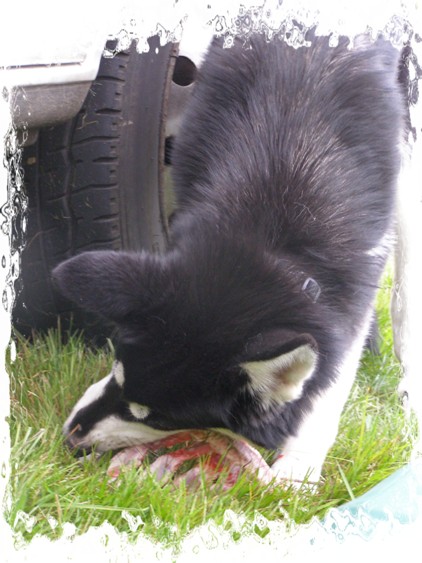 "Cloud" enjoys tucking into a rack of lamb ribs during a camping trip |
|
THE BARF DIET AND NATURAL FEEDING The BARF diet is one of the most controversial and misunderstood concepts in canine nutrition. Whilst it can work perfectly well, it imposes unnecessary strictures. Although the basic idea is appealing because it is simple and generally sound, putting it into practice requires more research, consideration, time and effort, than many people can, or are prepared, to find. The Barf Diet is idealistic and as such, difficult to achieve. Feeding adequately according to this method is not as simple as it may first appear, largely because of the inability to identify and source materials of the right quality, an inescapable fact associated with the products of modern farming methods and distribution. Many dog owners have used the BARF feeding method very successfully and this is because they have both the knowledge and experience to put this concept into practice, but many fail because of various problems. The latter come into two categories; they either give up because it is messy, smelly, and time consuming and return to a commercially prepared diet; or they persevere with a depleted version of the BARF diet, or a poorly conceived concoction of BARF and other ingredients, both bringing with them the inevitable negative consequences on health. Generally, the BARF diet reflects the natural diet of the dog, i.e. Natural Feeding, but, despite its appealing apparent simplicity, it should not be embarked upon without a full understanding of the ingredients required and the way to feed them. It should not be used unless the owner has at least a basic level of understanding of nutrition. The central issues are what raw materials to use in order to provide an appropriate range and quality of proteins, carbohydrates, vitamins and other nutrients. The starting point here is an appreciation of the evolved requirements of the species. The BARF diet is an acronym for Biologically Appropriate Raw Food. It was coined by an Australian veterinary surgeon by the name of Ian Billingshurst who suggested that many modern dog foods were causing problems basically because – 1. They contain high levels of unsuitable carbohydrates, depleted byproducts and artificial additives. 2. Cooking reduces the nutritional value of the food Billingshust therefore proposes a diet of raw meat and vegetables together with raw bones. The basic tenets of the BARF diet are consistent with Natural Feeding in that it follows the evolved requirements of the species; by-products and artificial additives are certainly not consistent, however Billingshurst is against the inclusion of any grain carbohydrate in the diet on the grounds that it is not digestible and the dog has not evolved to cope with it. However, the wild dog has always ingested grain carbohydrates from the stomach content of its prey and it can be argued that feeding them is generally compatible with its evolved physiology. Grain cereals can certainly cause problems and attention has been drawn to these recently, but it is usually not the presence of carbohydrate in the diet which causes the problem, but the type and the amount. Billingshurst is also against cooking, but whereas overcooking can deplete nutrients drastically, gentle cooking does not have this affect. So both these are question of degree. Main points for Natural Feeding • Carbohydrates from cereals can be a part of the dog’s diet. There is no convincing theoretical or scientific evidence to the contrary. The point is to give a range of different types and not too much. • For a dog in good digestive order about one third carbohydrate, one third meat, and one third vegetables seems to be about right. This may have to be adjusted according to other factors, such as age, life style, or other factors. • Feeding dogs is a simple matter provided the food given reflects the dog’s natural requirements. If good quality raw materials are used, complicated regimes and specialist commercial diets are not usually necessary. • If the food is being prepared from scratch it is important to ensure that all nutrients are provided in a proper form. Knowledge of canine nutrition is required to provide a balanced diet. • It should be remembered that all dogs are individuals and they like variety. Boredom with the same diet on a daily basis is one reason for ‘fussiness’. • If bones are being fed it is vital that should be given raw and there are other simple rules to follow. • Meat can be fed raw but dogs may have to be changed over from cooked diets very slowly. Carbohydrates and vegetables must be processed or the dog cannot digest them properly. This should be done by liquidising or gentle cooking. • A more convenient alternative to home preparation of all individual ingredients is to use a BAHNM Certified Holistic Food as a base diet, say 75-80%, with the addition of other fresh and raw ingredients. That way the owner can get the best of both worlds. (Note that this practice is not advised by the manufacturers of highly processed conventional non-certified diets) For free information on integrated nutrition and medicine and for advice in specific circumstances contact: tech.help@bahnm.org.uk
|

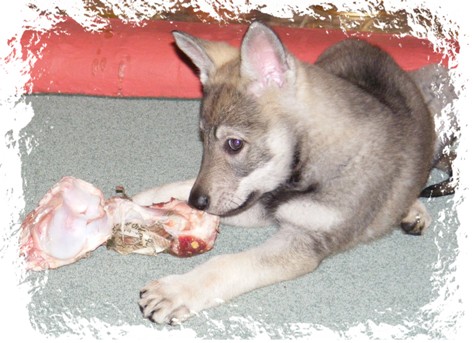 "Quest" 8 weeks old enjoys a bone |
|
Still not convinced that Natural Feeding is best? Have you considered what goes into the convenience dog foods? Read the labels on the complete dog food bags. If you imagine chicken or lamb on the label means it contains actual fresh meat then think again. With the exception of the manufacturers listed on my Links page you will more often than not find that the words chicken or lamb 'derivatives' or 'by products' are listed amongst the ingredients. The dictionary definition of a derivative reads as follows, “based on or making use of other sources; not original or primary” in other words if the label reads meat derivative, it’s not meat but what’s left over after the meat is taken away, fat, gristle, bones, heads, feet, feathers etc. The dictionary definition of a by-product is “ a secondary or incidental product of a manufacturing process”. If the manufacturer claims it doesn't contain any artificial preservatives, how come it doesn't go off? Preservatives like BHA, BHT and ethoxyquin which have been implicated in a whole host of health and behavioural problems. Artificial colourings and flavourings are also known to cause behavioural problems. Dogs don't actually need carbohydrates - cereals such as wheat, oats and rice are added to bulk out the food. Oils - these are more often than not the residue returned for 'recycling' by chip shops and the like. Calcium - you imagine this to be bone - chalk is also calcium but is not a digestible form. Added vitamins - only added because they were missing in the first place. New Improved .... - if it was supposed to be a completely balanced diet in the first place, why would it need improving? Tinned dog food is no better - a very high proportion of the content is water. If you are still not convinced, take a few minutes to read the following article, which makes the connection between the decline in canine health and the introduction of manufactured dog food. .The incidence of problems increased in direct relation to the increase in dog food manufacture and consumption. It's food for thought! |

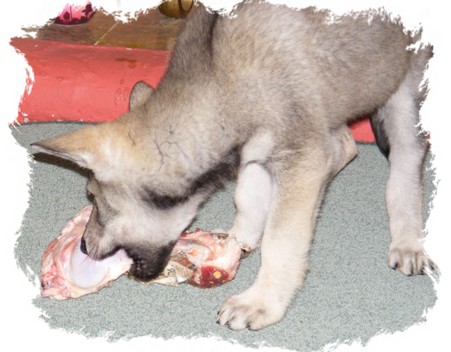 "Quest" - Czechoslovakian Wolfdog pup - enjoys BARF |
|
The Error of the
Millennium in Veterinary Medicine The background Diseases of the
musculoskeletal system in dogs have been a considerable veterinary
problem for decades. Statistics compiled by the canine science
associations indicate that 70 - 75% of the entire canine population are
affected. More than half of the dogs of all breeds exhibit pathological
changes, especially of the acetabulum and femur, known as hip dysplasia
(HD) or canine hip dysplasia (CHD) The etiological or
causal background to canine hip dysplasia has hitherto generally been
assumed to be multi-factorial heredity. This term originates from farm
and slaughter animal breeding and postulates that not only heredity but
also environ-mental factors – especially nutrition – play a role in
determining characteristics. The relative importance of these factors is
expressed as the degree of heritability. For CHD, percentage values of
up to 60 % have been assumed or, with reference to 1, of 0.2 to 0.6.
The dog breeding associations in the United
States, United Kingdom, France and Germany developed X-ray systems
designed to detect and combat hip dysplasia. But only in Germany and
several other European countries was it attempted to eliminate CHD
through selection, by excluding the dogs exhibiting this condition from
breeding in the populations of the different breeds. These genetic
measures, however, proved fruit-less over a period of three decades. The
Verband für das Deutsche Hundewesen (VDH) (German Kennel Club) failed in
its attempts to gain approval for this initiative from the American
Kennel Club (AKC), The Kennel Club (KC) or the Société Centrale Canine
(SCC) in France. Veterinarians in the
Western countries have traditionally advocated a “balanced diet” –
with-out specifying further details – and have left it to the animal
feedstuffs industry to provide dogs with “optimized complete diets”. At
present, around 80 – 90 % of the total canine population is being fed
completely or partially with industrially manufactured pre-formulated
food, which has consequently become accepted as “healthy dog food”.
These new feeding methods, however, have been unable to significantly
improve morbidity in terms of canine hip dysplasia. Indeed, there is
also a very high total morbidity level of numerous nutritional diseases
affecting various organ systems. Marc Torel and Klaus
Dieter Kammerer – a veterinarian and a scientific journalist with
medical training – believe that breeding programs and industrially
produced dog food in its present form cannot hope to bring about any
fundamental improvements in the incidence of canine hip dysplasia
because CHD is not heritable and because existing dog food does not
prevent, but is in fact the original cause of CHD. In these authors
view, canine hip dysplasia is induced solely by malnutrition.
An article in the TU caused a worldwide sensation In 1996, the
respected German journal “Tierärztliche Umschau” (TU) (Veterinary
Review) published the continuation article “Topical notes on canine hip
dysplasia” by Marc Torel and Klaus Dieter Kammerer, in which these
authors traced the entire history of the development of canine hip
dysplasia. They claimed that the hereditary nature of CHD had never been
conclusively proven and is not supported by any objective evidence, and
that breeding programs over three decades were thus inevitably doomed to
failure (Tierärztliche Umschau, Volume 51, pp. 455 ff., 1996).
In the opinion of Torel/Kammerer, everything
points to the probability that CHD has an alimentary/ hormonal etiology
and pathogenesis associated with malnutrition and increased production
of somatotropin, tri-iodothyronine (T3), thyroxine (T4),
parat-hormone and insulin-like growth factor IGF-I in the canine
organism. The authors went on to draw conclusions regarding the
nutrition and keeping of dogs and gave recommendations for the
prevention of their skeletal diseases. The essence of their
argument is that CHD is of nutritional and hormonal origin. Malnutrition
causes increased production of growth hormone, the thyroid hormones tri-iodothyronine
and thyroxine, parat-hormone and insulin-like growth factor in dogs. The
authors give a detailed analysis of the malnutrition and its adverse
skeletal effects. The book aroused
great interest among veterinarians and met with a worldwide response.
The authors and the editors of TU have received consistently positive
feedback from the USA, the whole of Europe, South Africa and Australia.
The Thirty Years‘ War and its bitter struggles
These sensational “Topical notes” formed the basis
for the Compendium
The title is a deliberate reference to the
religious war of 1618-1648 in Central Europe, since the attempts to
combat hip dysplasia in the associations and societies, as described by
the authors with more than a touch of irony, were not only characterized
by the ferocity of a military campaign but, in the face of prevailing
dogmatism, were also ultimately futile.
When these measures failed to prevent the distribution of the Compendium
by word of mouth, Waltham/ Effem persuaded the BTK and the VDH to apply
to Dortmund District Court to have the book banned. When even a
temporary injunction obtained from the biased and prejudicially
influenced 7th Civil Division on 23 Sept.1999 failed to halt the sale of
the book, the VDH intrigued with the Association of Publishers and
Booksellers of the Federal Republic of Germany in Frankfurt and on 10
Feb. 2000 the book title was deleted from the list of available books
(VLB list) This meant that "The Thirty Years' War" was effectively
placed on the index of prohibited books, since it was no longer
available through the book trade, or only with great difficulty. The
first legal actions taken against the Association at Frankfurt District
Court have so far been unsuccessful due to behind the scenes
manipulation among the judges in Dortmund and Frankfurt resulting in
agreements preferential to the VDH and its backers. Meanwhile, however,
a promise has been extracted that the book will be reinstated and
available once more through the book trade.
On the other hand, Christa Bremer, 3rd President of the VDH, its
Secretary Bernhard Meyer and permanent legal adviser Claudia Marienfeldt
are now under investigation by Dortmund Public Prosecutors Office on
suspicion of making a false statutory declaration and giving false
evidence in the course of proceedings. Investigative proceedings are
also pending at the same Office into the incorrect and biased presiding
judge Becker of the 7th Civil Division and his associate judges
Altemeier and Meyer-Tegenthoff due to the suspicion of perverting the
course of justice. The presiding judge of Hamm Higher Regional Court is
also conducting a disciplinary review into manipulation and suspicion of
corruption in Dortmund.
The "trio infernale" have no alternative but to defame and attempt to
completely discredit the authors Torel/Kammerer, whose charges, if
proved correct, would disgrace and compromise in an unprecedented manner
the leading figures of canine science, the veterinary profession and
animal foodstuffs industry for their blundering and charlatanism
continuing over decades. The Compendium "The Thirty Years' War" has
become a full-blown political issue.
One year later, on
10 Mar. 2000, Klaus Dieter Kammerer published his new book entitled
“The Error of the
Millennium in Veterinary Medicine” subtitled
“Malnutrition-induced Hip Dysplasia as a The “trio infernale”
have no alternative but to defame and attempt to completely discredit
the authors Torel/Kammerer, whose charges, if proved correct, would
disgrace and compromise in an unprecedented manner the leading figures
of canine science, the veterinary profession and animal feedstuffs
industry for their blundering and charlatanism continuing over decades.
The Compendium “The Thirty Years War” and the Compendium “The Error of
the Millennium in Veterinary Medicine” has become a full-blown political
issue. The author piles
fact upon fact to create an impressive, many coloured mosaic that
ultimately portrays a dismal scenario:
The 12 theses of
Klaus Dieter Kammerer:
3. The principle
applied in the manufacture of modern dog food was adopted from the mass
production of domestic and slaughter animals, especially calf and pig
fattening. Calves and piglets are fed a mixture of the primary nutrients
carbohydrates, proteins, fats,
calculated to induce rapid growth and weight gain.
For retail trade purposes, the 25 and 50 kg bags of calf and pig food
were repackaged for dogs into small packs and cans with a water content
of up to 80 %. This food differs from slaughter animal feed only by the
inclusion of synthetic aromatisers, flavouring agents and attractants
specific to dogs, and by the elaborate packaging. One further
difference, however, is that to dupe consumers dog food also contains
soya designed – sometimes into the very fibre structures - to simulate
meat and “meaty lumps”. The genetic manipulation of soya results in
lipid deposits in the organs and the content of phytoestrogens leads to
pathological changes in the skeleton:
“Frankenstein Food” So not only the
alleged heritability of CHD has been adopted from domestic and slaughter
animal breeding, but also its nutritional basis.
6. It
is perhaps one of the ironies of fate that CHD is indeed a
multifactorial disease, with a variety of nutrition-induced underlying
disorders as possible causative factors:
·
Hormonal dysfunctions (IGF-I, T3,
T4, Parathormon, Estrogene)
10. The veterinary profession too is now firmly in
thrall to these multinational corporations. Many veterinarians owe their
living to this mutual sleaze and corruption. Of the 20,000 practising
veterinarians in the Federal Republic of Germany, about 20-25% are
unemployed anyway and another 20-25 % would have to shut up shop if they
didn’t receive the average Euro 20,000 – 25,000 annually from the sale
of special diet feeds and the X-ray system of the VDH (German Kennel
Club) they need to cover their practice costs (rent, staff).
Considerable benefits in cash and kind find their way to students of
veterinary medicine, medical-technical assistant personnel and the
veterinarians themselves. The opinion-leading veterinarians and
nutritional scientists at the institutes of animal nutrition are almost
without exception bribed and travel around the world at the expense of
the various companies. They therefore recommend these products from
sheer self-interest and regale dog owners with the benefits of
industrial dog food while keeping quiet about the disadvantages. Since
the entire advertising budgets are funded from the turnover and hence
from the sales prices of the various brands, consumers and dog owners
are actually paying out of their own pockets for the brainwashing to
which they are continually subjected, not even realizing that these by
no means so optimized products are also grossly overpriced. The same or
similar conditions prevail in the other countries.
|

"You can take the dog out of the Wolf pack, but you can't take the Wolf pack out of the dog"
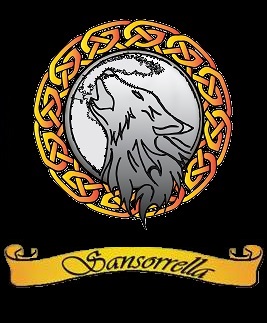
![]() Sansorrella 2019 All rights reserved
Sansorrella 2019 All rights reserved